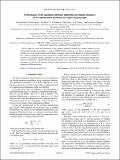Performance of the quantum adiabatic algorithm on random instances of two optimization problems on regular hypergraphs
Author(s)
Farhi, Edward; Shor, Peter W.; Gosset, David Nicholas; Hen, Itay; Sandvik, A. W.; Young, A. P.; Zamponi, Francesco; ... Show more Show less
DownloadFarhi-2012-Performance of the quantum adiabatic algorithm on random instances of two optimization problems on regular hypergraphs.pdf (915.9Kb)
PUBLISHER_POLICY
Publisher Policy
Article is made available in accordance with the publisher's policy and may be subject to US copyright law. Please refer to the publisher's site for terms of use.
Terms of use
Metadata
Show full item recordAbstract
In this paper we study the performance of the quantum adiabatic algorithm on random instances of two combinatorial optimization problems, 3-regular 3-XORSAT and 3-regular max-cut. The cost functions associated with these two clause-based optimization problems are similar as they are both defined on 3-regular hypergraphs. For 3-regular 3-XORSAT the clauses contain three variables and for 3-regular max-cut the clauses contain two variables. The quantum adiabatic algorithms we study for these two problems use interpolating Hamiltonians which are amenable to sign-problem free quantum Monte Carlo and quantum cavity methods. Using these techniques we find that the quantum adiabatic algorithm fails to solve either of these problems efficiently, although for different reasons.
Date issued
2012-11Department
Massachusetts Institute of Technology. Center for Theoretical Physics; Massachusetts Institute of Technology. Computer Science and Artificial Intelligence Laboratory; Massachusetts Institute of Technology. Department of Mathematics; Massachusetts Institute of Technology. Department of PhysicsJournal
Physical Review A
Publisher
American Physical Society
Citation
Farhi, Edward et al. “Performance of the Quantum Adiabatic Algorithm on Random Instances of Two Optimization Problems on Regular Hypergraphs.” Physical Review A 86.5 (2012). © 2012 American Physical Society
Version: Final published version
ISSN
1050-2947
1094-1622